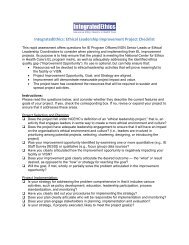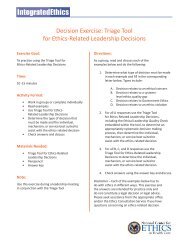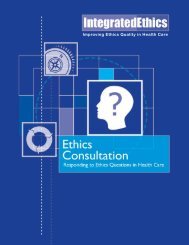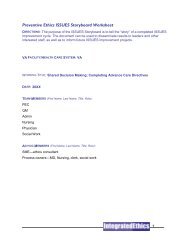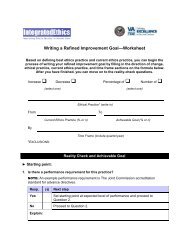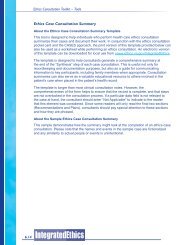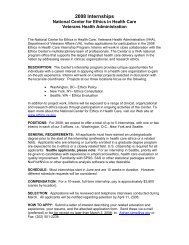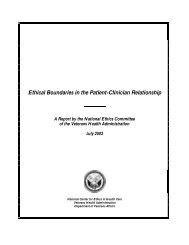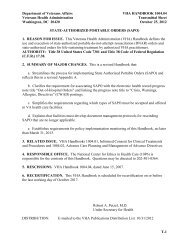Preventive Ethics - National Center for Ethics in Health Care - US ...
Preventive Ethics - National Center for Ethics in Health Care - US ...
Preventive Ethics - National Center for Ethics in Health Care - US ...
You also want an ePaper? Increase the reach of your titles
YUMPU automatically turns print PDFs into web optimized ePapers that Google loves.
Part III: ISSUES—A Step-by-Step Approach to <strong>Preventive</strong> <strong>Ethics</strong><br />
Step 3: Select a Strategy<br />
With a clear understand<strong>in</strong>g of the ethics quality gap, the team should next work to identify<br />
the probable causes of the gap, bra<strong>in</strong>storm potential improvement strategies to narrow it,<br />
and focus <strong>in</strong> on a particular strategy.<br />
S SELECT<br />
a Strategy<br />
Identify the major cause(s) of the ethics quality gap<br />
Bra<strong>in</strong>storm possible strategies to narrow the gap<br />
Choose one or more strategies to try<br />
Identify the major cause(s) of the ethics quality gap<br />
Many methods can be used to identify causes of the gap between current practices and<br />
best practices. One of the more common is root cause analysis, which is often applied to<br />
patient safety <strong>in</strong>cidents. VA policy def<strong>in</strong>es root cause analysis as “a process <strong>for</strong> identify<strong>in</strong>g<br />
the basic or contribut<strong>in</strong>g causal factors that underlie variations <strong>in</strong> per<strong>for</strong>mance.”[52] A<br />
root cause is “one of multiple factors (events, conditions or organizational factors) that<br />
contributed to or created the proximate cause and subsequent undesired outcome and, if<br />
elim<strong>in</strong>ated or modified, would have prevented the undesired outcome.”[53] Typically, multiple<br />
causes contribute to the gap between current practices and best practices.<br />
Root cause analysis:<br />
• focuses primarily on systems and processes rather than <strong>in</strong>dividual per<strong>for</strong>mance<br />
• <strong>in</strong>vestigates the underly<strong>in</strong>g systems through a series of “why” questions<br />
• cont<strong>in</strong>ues until all aspects of the process are reviewed and all contribut<strong>in</strong>g factors<br />
are considered<br />
• identifies changes that could be made <strong>in</strong> systems and processes through either<br />
redesign or development of new processes or systems that would improve<br />
per<strong>for</strong>mance[46]<br />
Just as mapp<strong>in</strong>g the process beh<strong>in</strong>d a practice (<strong>in</strong> Step 2) requires collect<strong>in</strong>g <strong>in</strong><strong>for</strong>mation<br />
directly from people who are <strong>in</strong>volved, identify<strong>in</strong>g the major causes of an ethics quality gap<br />
also requires <strong>in</strong>put from people who know and/or use the process. Secondhand conjecture<br />
about other people’s motives isn’t reliable. For example, program staff may believe that<br />
elderly patients don’t use automated telephone help systems because “they’d rather talk to<br />
someone face to face,” when the real reason is that these patients have slow reaction times<br />
and can’t push buttons <strong>in</strong> the time allowed.<br />
A cause-and-effect (or “fishbone”) diagram can also be a useful tool to graphically represent<br />
potential causes <strong>for</strong> why there is a gap and help to focus the team on what causes might be<br />
most amenable to change. Figure 5 shows an example of a fishbone diagram illustrat<strong>in</strong>g<br />
the causes beh<strong>in</strong>d one facility’s failure to identify potential surrogates dur<strong>in</strong>g the hospital<br />
admissions process:<br />
43



